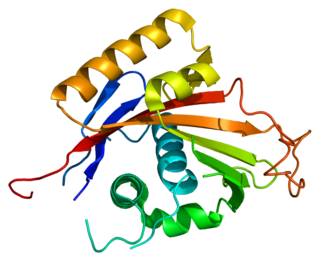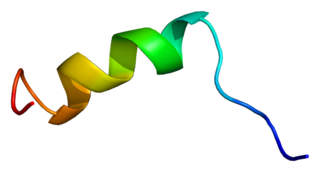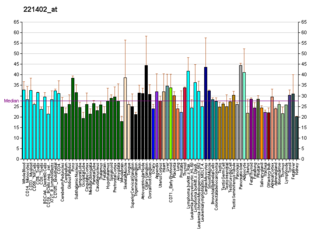Related Research Articles

Familial hypercholesterolemia (FH) is a genetic disorder characterized by high cholesterol levels, specifically very high levels of low-density lipoprotein, in the blood and early cardiovascular disease. The most common mutations diminish the number of functional LDL receptors in the liver. Since the underlying body biochemistry is slightly different in individuals with FH, their high cholesterol levels are less responsive to the kinds of cholesterol control methods which are usually more effective in people without FH. Nevertheless, treatment is usually effective.
The neonatal Fc receptor is a protein that in humans is encoded by the FCGRT gene. It is an IgG Fc receptor which is similar in structure to the MHC class I molecule and also associates with beta-2-microglobulin. In rodents, FcRn was originally identified as the receptor that transports maternal immunoglobulin G (IgG) from mother to neonatal offspring via mother's milk, leading to its name as the neonatal Fc receptor. In humans, FcRn is present in the placenta where it transports mother's IgG to the growing fetus. FcRn has also been shown to play a role in regulating IgG and serum albumin turnover. Neonatal Fc receptor expression is up-regulated by the proinflammatory cytokine, TNF-α, and down-regulated by IFN-γ.

Probable phospholipid-transporting ATPase IC is an enzyme that in humans is encoded by the ATP8B1 gene. This protein is associated with progressive familial intrahepatic cholestasis type 1 as well as benign recurrent intrahepatic cholestasis.

The CLCN5 gene encodes the chloride channel Cl-/H+ exchanger ClC-5. ClC-5 is mainly expressed in the kidney, in particular in proximal tubules where it participates to the uptake of albumin and low-molecular-weight proteins, which is one of the principal physiological role of proximal tubular cells. Mutations in the CLCN5 gene cause an X-linked recessive nephropathy named Dent disease characterized by excessive urinary loss of low-molecular-weight proteins and of calcium (hypercalciuria), nephrocalcinosis and nephrolithiasis.

Frizzled-2 is a protein that in humans is encoded by the FZD2 gene.

Frizzled-5 is a protein that in humans is encoded by the FZD5 gene.

Sodium/potassium-transporting ATPase subunit alpha-2 is a protein which in humans is encoded by the ATP1A2 gene.

5'-AMP-activated protein kinase subunit gamma-2 is an enzyme that in humans is encoded by the PRKAG2 gene.

Electrogenic sodium bicarbonate cotransporter 1 (NBCe1) is a membrane transport protein that in humans is encoded by the 'SLC4A4' gene.

Progressive ankylosis protein homolog is a protein that in humans is encoded by the ANKH gene.

Alsin is a protein that in humans is encoded by the ALS2 gene. ALS2 orthologs have been identified in all mammals for which complete genome data are available.

Navα1.2, also known as the sodium channel, voltage-gated, type II, alpha subunit is a protein that in humans is encoded by the SCN2A gene. Functional sodium channels contain an ion conductive alpha subunit and one or more regulatory beta subunits. Sodium channels which contain the Navα1.2 subunit are called Nav1.2 channels.

Golgi-associated PDZ and coiled-coil motif-containing protein is a protein that in humans is encoded by the GOPC gene.

Myosin-11 is a protein that in humans is encoded by the MYH11 gene.
Ig delta chain C region is a protein that in humans is encoded by the IGHD gene.

Integral membrane protein 2B is a protein that in humans is encoded by the ITM2B gene.

Olfactory receptor 1F1 is a protein that in humans is encoded by the OR1F1 gene.

Voltage-dependent calcium channel gamma-3 subunit is a protein that in humans is encoded by the CACNG3 gene.

Rho-related BTB domain-containing protein 2 is a protein that in humans is encoded by the RHOBTB2 gene.

GPR182 is a human gene which is an orphan G-protein coupled receptor.
References
- ↑ Petitpas I, Petersen CE, Ha CE, et al. (May 2003). "Structural basis of albumin–thyroxine interactions and familial dysalbuminemic hyperthyroxinemia". Proceedings of the National Academy of Sciences, USA. 100 (11): 6440–5. Bibcode:2003PNAS..100.6440P. doi: 10.1073/pnas.1137188100 . PMC 164465 . PMID 12743361.
- ↑ Ruiz M, Rajatanavin R, Young RA, et al. (March 1982). "Familial dysalbuminemic hyperthyroxinemia: a syndrome that can be confused with thyrotoxicosis". New England Journal of Medicine. 306 (11): 635–9. doi:10.1056/NEJM198203183061103. PMID 6173750.